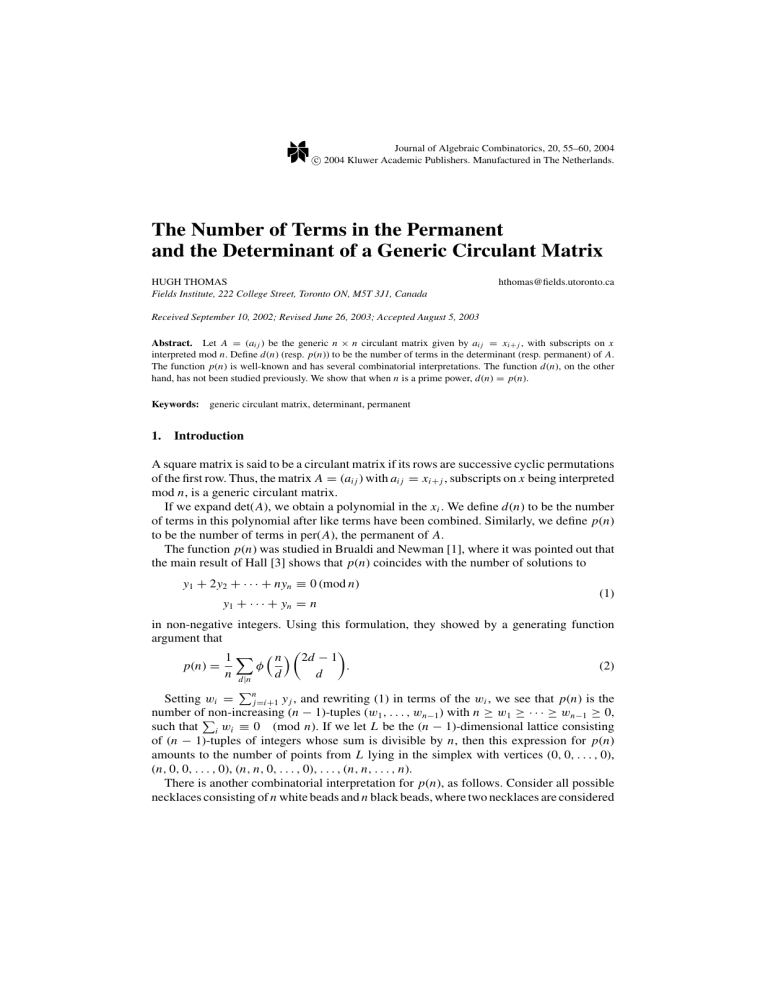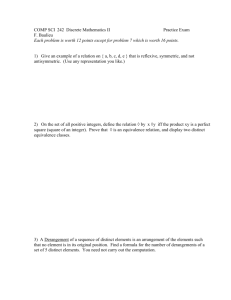The Number of Terms in the Permanent
advertisement

Journal of Algebraic Combinatorics, 20, 55–60, 2004
c 2004 Kluwer Academic Publishers. Manufactured in The Netherlands.
The Number of Terms in the Permanent
and the Determinant of a Generic Circulant Matrix
HUGH THOMAS
Fields Institute, 222 College Street, Toronto ON, M5T 3J1, Canada
hthomas@fields.utoronto.ca
Received September 10, 2002; Revised June 26, 2003; Accepted August 5, 2003
Abstract. Let A = (ai j ) be the generic n × n circulant matrix given by ai j = xi+ j , with subscripts on x
interpreted mod n. Define d(n) (resp. p(n)) to be the number of terms in the determinant (resp. permanent) of A.
The function p(n) is well-known and has several combinatorial interpretations. The function d(n), on the other
hand, has not been studied previously. We show that when n is a prime power, d(n) = p(n).
Keywords: generic circulant matrix, determinant, permanent
1.
Introduction
A square matrix is said to be a circulant matrix if its rows are successive cyclic permutations
of the first row. Thus, the matrix A = (ai j ) with ai j = xi+ j , subscripts on x being interpreted
mod n, is a generic circulant matrix.
If we expand det(A), we obtain a polynomial in the xi . We define d(n) to be the number
of terms in this polynomial after like terms have been combined. Similarly, we define p(n)
to be the number of terms in per(A), the permanent of A.
The function p(n) was studied in Brualdi and Newman [1], where it was pointed out that
the main result of Hall [3] shows that p(n) coincides with the number of solutions to
y1 + 2y2 + · · · + nyn ≡ 0 (mod n)
y1 + · · · + yn = n
(1)
in non-negative integers. Using this formulation, they showed by a generating function
argument that
1 n 2d − 1
p(n) =
φ
.
(2)
n d|n
d
d
Setting wi = nj=i+1 y j , and rewriting (1) in terms of the wi , we see that p(n) is the
number of
non-increasing (n − 1)-tuples (w1 , . . . , wn−1 ) with n ≥ w1 ≥ · · · ≥ wn−1 ≥ 0,
such that i wi ≡ 0 (mod n). If we let L be the (n − 1)-dimensional lattice consisting
of (n − 1)-tuples of integers whose sum is divisible by n, then this expression for p(n)
amounts to the number of points from L lying in the simplex with vertices (0, 0, . . . , 0),
(n, 0, 0, . . . , 0), (n, n, 0, . . . , 0), . . . , (n, n, . . . , n).
There is another combinatorial interpretation for p(n), as follows. Consider all possible
necklaces consisting of n white beads and n black beads, where two necklaces are considered
56
THOMAS
Table 1.
Values of d(n) and p(n) for small n.
n
d(n)
p(n)
n
d(n)
1
1
1
7
2
2
2
8
810
810
3
4
4
9
2704
2704
246
p(n)
246
4
10
10
10
7492
9252
5
26
26
11
32066
32066
6
68
80
12
86500
112720
equivalent if they differ by a cyclic permutation. A straightforward Pólya counting argument
shows that the number of such necklaces is given by the right-hand side of (2), and thus that
the number of necklaces equals the number of terms in per(A), though no explicit bijection
is known.
The other function we consider here, d(n), the number of terms in the expansion of the
determinant of a generic circulant matrix, does not have any known combinatorial interpretation. One motivation for its investigation is the consideration that interesting sequences
are known to arise as the number of terms in the expansion of n × n generic matrices of
other types. Clearly, the expansion of the determinant of a completely generic matrix, where
the matrix entries consist of n 2 different indeterminates, has n! terms. The same is true for
the expansion of a generic Vandermonde matrix. Somewhat less trivially, if we consider
matrices with generic entries in the diagonal, subdiagonal, and superdiagonal, and zeros
elsewhere, we find that the number of terms in the expansion of the determinant is the
n-th Fibonacci number, as it is easily seen to satisfy the Fibonacci recursion and initial
conditions.
Previously, little was known about d(n). Some initial results appear in Lehmer [4]. It is
clear that d(n) ≤ p(n) since every term which appears in the determinant also appears in the
permanent. However, some terms from the permanent could be absent from the determinant
due to cancellation. In this paper we establish the following theorem:
Theorem If n is a prime power, d(n) = p(n).
The above table of values for d(n) and p(n) suggests that the converse may also be true.
This is still open.
The proof of the theorem uses the theory of symmetric functions. In this section, we
review the necessary definitions and results. For more detail on symmetric functions, see
Stanley [5].
2.
Background on symmetric functions
Symmetric functions are power series (in our case, over Q) in an infinite number of variables
z 1 , z 2 , . . . , such that for any (b1 , . . . , bk ) ∈ Nk the coefficient of z ib11 . . . z ibkk does not depend
on the choice of distinct natural numbers i 1 , . . . , i k .
DETERMINANT OF A GENERIC CIRCULANT MATRIX
57
We write λ q to signify that λ is a partition of q. The symmetric functions of degree
q form a vector space whose dimension is the number of partitions of q. There are several
standard bases for them. We shall need two here: {m λ | λ q} and { pλ | λ q}. For
λ = (λ1 , . . . , λk ) with λ1 ≥ λ2 ≥ · · · ≥ λk , m λ is the power series in which z iλ11 . . . z iλkk
occurs with coefficient one for every distinct sequence of natural numbers i 1 , . . . , i k and
no other terms occur. The symmetric function pi is defined to be z 1i + z 2i + . . . , and the
symmetric function pλ is defined to be pλ1 . . . pλk .
As we remarked, { pλ | λ q} and {m λ | λ q} form bases for the symmetric functions
of degree q. We will need to convert from the m λ basis to the pλ basis, which we shall do
using a result of Eğecioğlu and Remmel [2], for which we must introduce some notation.
For λ q, let k(λ) denote the number of parts of λ. If λ = 1l1 2l2 . . . q lq , let λ! =
l1 l2
1! 2! . . . q!lq , and let z λ = l1 ! . . . lq !1l1 2l2 . . . q lq .
The Ferrers diagram of λ consists of a left-justified column of rows of boxes of lengths
λ1 , λ2 , . . . , λk . For µ another partition of q, a filling of λ by µ is a way to cover the Ferrers
diagram of λ in a non-overlapping manner by “bricks” consisting of horizontal sequences
of boxes of length µ1 , µ2 , . . . . The weight of a filling is the product over all rows of the
length of the final brick in each row. In deciding whether two fillings are the same, bricks
of the same size are considered to be indistinguishable. Thus, the four fillings of λ = (4, 2)
by µ = (2, 2, 1, 1), having weights respectively 4, 2, 2, and 2, are:
Let w(λ, µ) be the sum over all distinct fillings of λ by µ of the weight of the filling.
Then the result we shall need from [2] is that:
(−1)k(µ)−k(λ) w(λ, µ)
mµ =
pλ .
zλ
λq
Proof of theorem
First, let us consider what terms occur in per(A). Let b = (b1 , . . . , bn ) be an n-tuple of
natural numbers summing to n. Let x b denote x1b1 x2b2 . . . xnbn . We are interested in whether x b
appears in per(A) with non-zero
coefficient. Suppose
it does. Then there is some permutation
σ of {1, . . . , n} such that i xi−σ (i) = x b . Since i (i −σ (i)) = 0, it follows that i ibi ≡ 0
(mod n). By the result of [3] mentioned above, this necessary condition for x b to occur in
per(A) is also sufficient.
Now we proceed to consider det(A). Let ξ be a primitive
diago n-th root of unity. A is nalizable, and its eigenvalues are c1 , . . . , cn , where ci = j ξ i j x j . Thus, det(A) = ci .
Again, let b = (b1 , . . . , bn ) be an n-tuple of integers summing to n. Let q = b1 + 2b2 +
· · · + nbn . Let µ = 1b1 2b2 . . . n bn , so µ q. Then [x b ] det(A), the coefficient of x b in
det(A), is given by
[x b ] det(A) =
f :{1,...,n}→{1,...,n}
| f −1 (i)|=bi
ξ
n
i=1
if (i)
.
58
THOMAS
We observe that this also equals m µ (ξ 1 , ξ 2 , . . . , ξ n , 0, 0, . . .). (A symmetric function is a
power series, so it is not generally legitimate to substitute in values for the indeterminates,
but since m µ is homogeneous and all but finitely many of the values being substituted are
zero, it is allowed in this case.)
Now we use the result of [2] mentioned above, which shows that:
[x b ] det(A) =
(−1)k(µ)−k(λ) w(λ, µ) pλ (ξ 1 , ξ 2 , . . . , ξ n , 0, 0, . . .)
λq
zλ
.
(3)
What can we say about pλ (ξ 1 , ξ 2 , . . . , ξ n , 0, 0, . . .)? Firstly, pi (ξ 1 , ξ 2 , . . . , ξ n , 0, 0, . . .) =
n if n | i and 0 otherwise. Thus, pλ (ξ 1 , ξ 2 , . . . , ξ n , 0, 0, . . .) = n k(λ) if all the parts of λ are
multiples of n, and 0 otherwise.
(From this we could deduce that if [x b ] det(A) is non-zero, q = b1 + 2b2 + · · · + nbn
must be a multiple of n. Of course, we already know this, by the argument given when
discussing per(A).)
To establish our result, we must now show that if q is a multiple of n and n is a prime
power, then the sum in (3) is non-zero. So assume that n = pr , p a prime. Let v : Q× → Z
denote the usual valuation with respect to p.
For λ any partition of q, divide the fillings of λ by µ into equivalence classes where two
fillings are equivalent if one can be obtained from the other by rearranging the bricks within
each row, and by swapping the sets of bricks filling pairs of rows of equal length.
We wish to show that the contribution to (3) from the partition q (all of whose fillings
form a single equivalence class) has a smaller valuation than the sum of weights of the
fillings in any equivalence class of fillings of any other partition. Once this is established,
it follows that the sum (3) is non-zero.
Fix λ = (λ1 , λ2 , . . .) = 1l1 2l2 . . . q lq , with all the λi divisible by n, and fix an equivalence
class F of fillings of λ by µ. Write k for k(λ). Consider first a subclass of fillings G, those
which can be obtained from some fixed F ∈ F by rearranging the bricks in each row, but
without interchanging rows. Let the j-th row of the filling F of λ contain r j bricks. Let ei j
be the number of these bricks having length i. The number of rearrangements of this row
with ending in a brick of length i is ( e1 j ,...,erijj−1
).
−1,...,en j
Thus, the total weight of all the rearrangements of this row is:
n i=1
n
1
rj − 1
rj
i=
iei j
r e1 j , . . . , ei j , . . . , en j
e1 j , . . . , ei j − 1, . . . , en j
i=1 j
rj
1
λj.
=
r j e1 j , . . . , e n j
It follows that the total weight of all the fillings in G is:
k
1
rj
λj.
r e1 j , . . . , e n j
j=1 j
59
DETERMINANT OF A GENERIC CIRCULANT MATRIX
Consider the li parts of λ of length i. The equivalence class F determines a partition
γ (F, i) of li , where the parts of γ (F, i) are the sizes of the sets of rows of length i which
are filled with an indistinguishable set of bricks. The sum of all the weights over all the
fillings in F is:
q
k
li ! 1
rj
λj.
γ (F, i)! j=1 r j e1 j , . . . , en j
i=1
Writing δ(F) for the partition of k which is the sum of the γ (F, i) for all i, the contribution
to (3) from all these fillings is:
k
(r j − 1)!
(−1)k(µ)−k n k δ(F)!
e
! . . . en j !
j=1 1 j
(4)
Now let us consider (4) in the case where λ = q. Here, we obtain
(−1)k(µ)−1 n!
.
b 1 ! . . . bn !
(5)
We wish to show that (4) evaluated for any other equivalence class has a greater valuation
with respect to p than does (5). This is equivalent to showing that, for any λ = q, and any
equivalence class of fillings F, that the following expression has a positive valuation:
k
(r j − 1)!
nk
b1 ! . . . bn !
δ(F)! j=1 e1 j ! . . . en j !
n!
n
1 n k−1
bi
=
δ(F)! i=1 ei1 , . . . , eik
(n − 1) . . . (n − k + 1)
n−k
r1 −1,...,rk −1
.
(6)
We have written (6) as a product of two terms. We will show that the first term is an
integer, and therefore has non-negative valuation, and that the second term has positive
valuation, which will complete the proof.
For the first term, observe that if we rewrite the partition bi = ei1 + · · · + eik as
bi
1ci1 . . . n cin , then ci1 ! . . . cin ! divides ( ei1 ,...,e
) because
ik
1
bi
ci1 ! . . . cin ! ei1 , . . . , eik
counts the number of ways of dividing bi objects into subsets of certain sizes, where we
don’t distinguish the different subsets of the same size. The first term of (6) is now disposed
of by remarking that
δ(F)!|
n
ci1 ! . . . cin !
i=1
since each term in δ(F)! implies the existence of at least one equal term among the product
of factorials on the right hand side.
60
THOMAS
For the second term, we need the following simple lemma:
Lemma If m < p s ,
(i)
m
v
< s,
d
(ii)
v
m
d1 , . . . , dk
< (k − 1)s.
Proof:
v
m
m
d
(m − d)
=
−
−
+ ···
d
p
p
p
m
d
(m − d)
+
−
−
≤ 1 + · · · + 1 = s − 1.
p s−1
p s−1
p s−1
The second part follows immediately from repeated application of the first part, which
completes the proof of the lemma.
Now, we know that
v(n k−1 ) = (k − 1)r,
n−k
≤ (k − 1)(r − 1),
r1 − 1, . . . , rk − 1
v
v((n − 1) . . . (n − k + 1)) = v((k − 1)!) = k/ p + · · · <
k−1
≤ k − 1,
p−1
and the desired result follows.
Acknowledgments
I would like to thank Graham Denham for a useful suggestions and Jim Propp for asking
the question and for helpful comments on a previous draft.
References
1. R. Brualdi and M. Newman, “An enumeration problem for a congruence equation,” J. Res. Nat. Bur. Standards
Sect. B 74B (1970), 37–40.
2. Ö. Eğecioğlu and J. Remmel, “Brick tabloids and the connection matrices between bases of symmetric
functions,” Discrete Appl. Math. 34 (1991), 107–120.
3. M. Hall, Jr., “A combinatorial problem on abelian groups,” Proc. Amer. Math. Soc. 3 (1952), 584–587.
4. D. Lehmer, “Some properties of circulants,” J. Number Theory 5 (1973), 43–54.
5. R. Stanley, Enumerative Combinatorics, Volume 2 Cambridge University Press, Cambridge, 1999.







